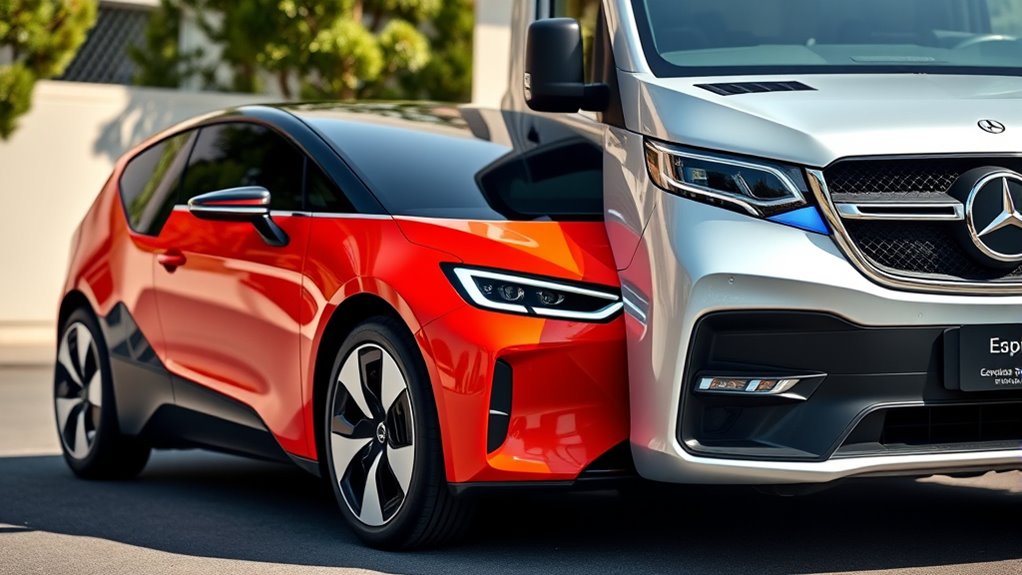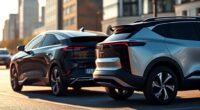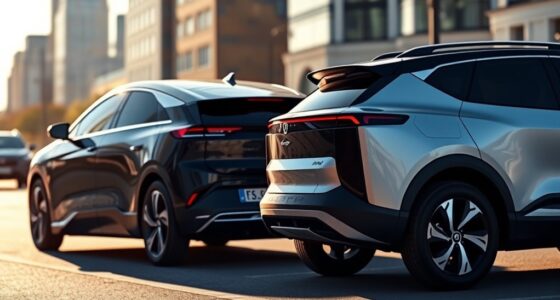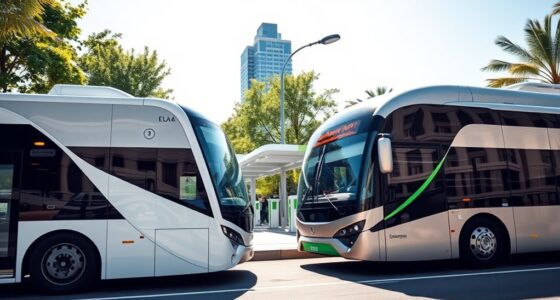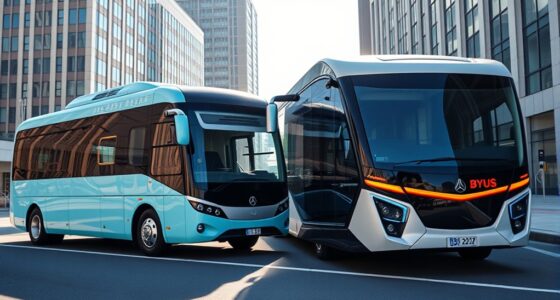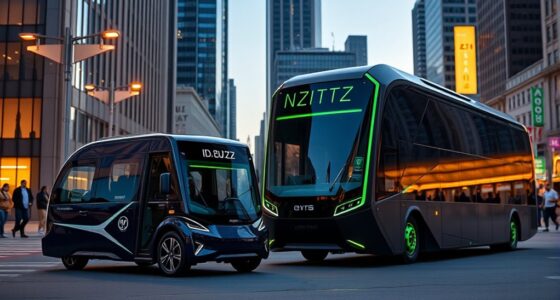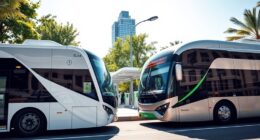The ID.Buzz is a stylish, compact electric van designed for urban lifestyle and versatility, priced around $60,000 to appeal to consumers seeking a fun, eco-friendly vehicle. The Mercedes eSprinter focuses on practicality, with higher load capacity, longer range, and fleet-oriented features, starting at about €60,000. While the ID.Buzz excels in maneuverability and design, the eSprinter offers utility and reliability. Continue exploring to see how these vans compare in performance, features, and support.
Key Takeaways
- The ID.Buzz targets urban consumers with stylish design and compact size, while the eSprinter focuses on commercial utility and cargo capacity.
- ID.Buzz offers a lower starting price and lifestyle-oriented features, whereas eSprinter emphasizes practicality and fleet versatility.
- Both vehicles include advanced safety tech and driver assistance, but the ID.Buzz emphasizes urban maneuverability and passenger comfort.
- The eSprinter provides higher payload capacity and longer range options for commercial delivery needs.
- Warranty and support differ, with ID.Buzz offering longer high-voltage battery coverage, while eSprinter emphasizes fleet and business service packages.
Price and Market Positioning
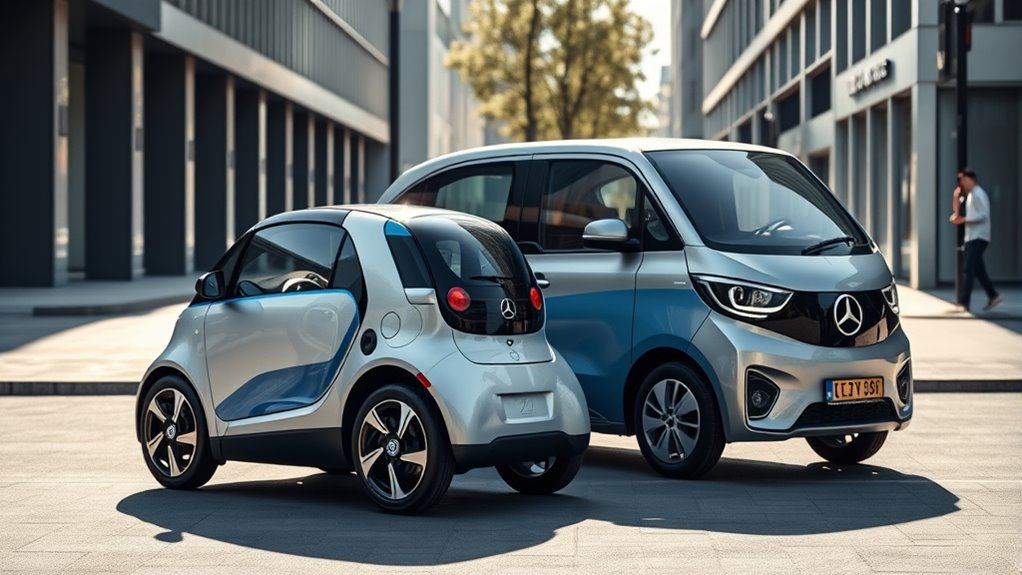
How do the ID.Buzz and Mercedes-Benz eSprinter compare when it comes to price and market positioning? The ID.Buzz starts at $59,995, going up to about $68,040 for higher trims. It’s marketed as a lifestyle vehicle with retro styling, justifying its premium price point of over $60K.
In contrast, the eSprinter’s commercial focus means its pricing is generally higher than traditional gas or diesel Sprinters, with European models beginning around €60,000. Mercedes targets fleet operators and businesses with configurations emphasizing utility, not style.
Limited dealer allocations for the ID.Buzz could lead to markups, while the eSprinter’s availability depends on fleet orders. Overall, the ID.Buzz aims at consumers seeking a stylish, versatile EV, whereas the eSprinter appeals to commercial buyers prioritizing functionality.
Additionally, the market positioning of each vehicle reflects their distinct target audiences and intended uses, with the ID.Buzz emphasizing lifestyle appeal and the eSprinter focusing on practicality and utility. Understanding the vehicle segment distinctions can help buyers choose the right fit for their needs. Recognizing the importance of cost considerations and total ownership expenses can further inform purchasing decisions in this segment. A thorough understanding of market differentiation can assist buyers in making informed choices aligned with their priorities.
Powertrain Performance and Range
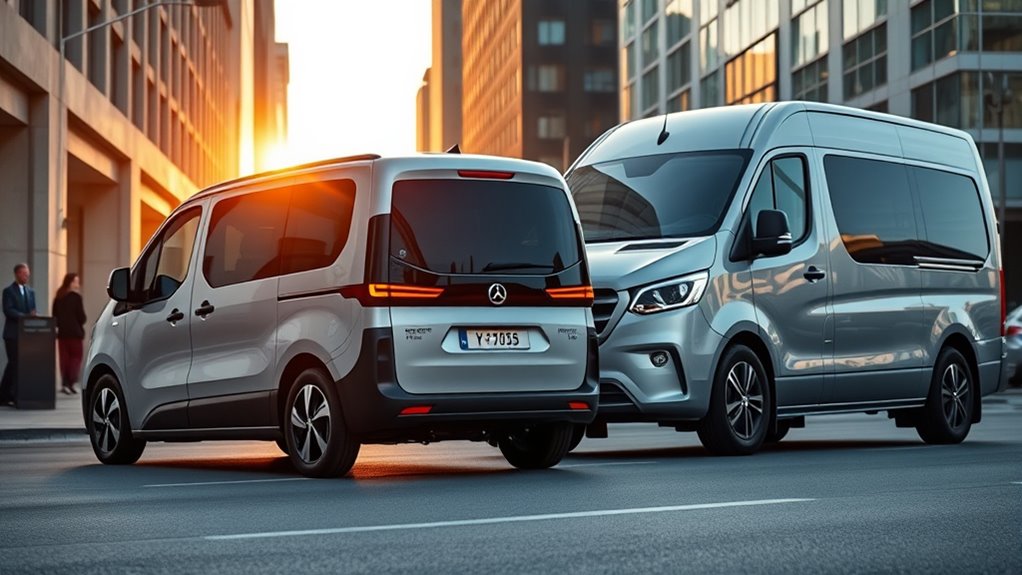
When comparing the powertrain performance and range of the ID.Buzz and Mercedes-Benz eSprinter, it’s clear that they serve different priorities.
The eSprinter offers two motor options—134 hp and 201 hp—with the high-output delivering 295 lb-ft of torque, rear-wheel drive, and a top speed limited to 75 mph. It accelerates to 60 mph in about 12.7 seconds and can tow up to 4,277 pounds.
The eSprinter offers 134 or 201 hp, 295 lb-ft torque, 75 mph top speed, 0-60 in 12.7 sec, and 4,277 lbs towing capacity.
Its range varies from around 142 miles on highways to 271 miles in city conditions, with a simulated WLTP range of up to 440 km. Charging is fast, reaching 80% in about 42 minutes at 115 kW. Additionally, the vehicle’s performance metrics are designed to meet commercial delivery demands efficiently. This emphasis on battery capacity and fast charging capabilities makes it suitable for logistics and delivery services. A drivetrain configuration tailored for commercial use further enhances its utility in various operational environments.
The ID.Buzz’s powertrain details aren’t specified, but it typically features around 201 hp, prioritizing a balance of performance and efficiency suited for urban and recreational use.
Dimensions, Maneuverability, and Urban Use
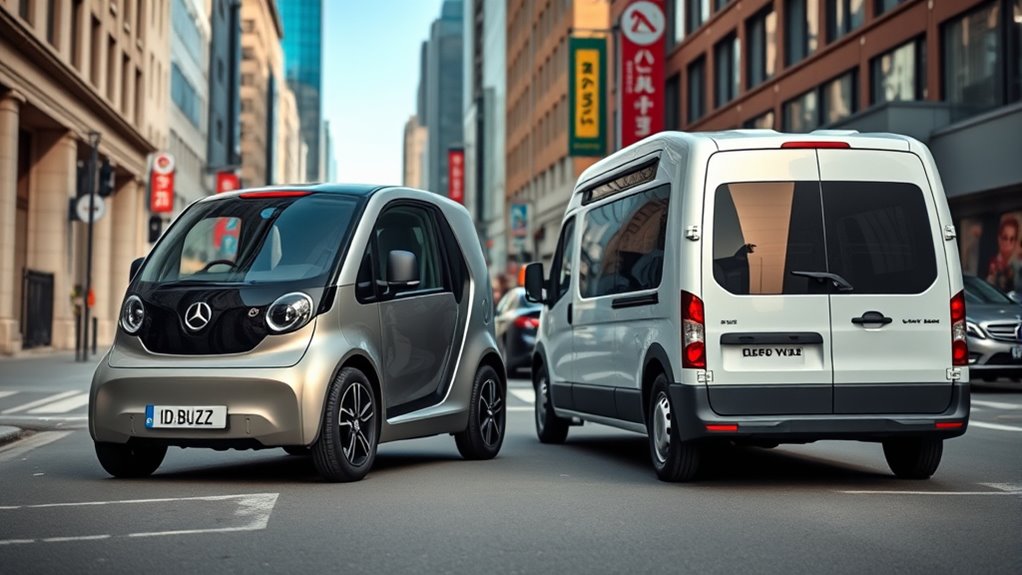
The ID.Buzz’s compact dimensions make it highly maneuverable in urban environments, allowing you to navigate tight streets and park with ease. Its length under 5 meters and a shorter wheelbase of 2,989 mm enable sharper turns and better agility compared to the longer eSprinter, which measures over 6.9 meters. Additionally, the smaller size contributes to a lower carbon footprint, making it an environmentally friendly choice for city driving. The ID.Buzz’s lower height of 1,927 mm improves visibility and makes parking in low-clearance garages simpler. Its front-wheel-drive setup likely delivers a tighter turning radius, enhancing city driving. The vehicle’s smaller footprint and easier curbside access make loading and unloading more convenient. Additionally, its electric design reduces noise and emissions, making it well-suited for urban zones with strict regulations. An important aspect to consider is urban vehicle efficiency, which the ID.Buzz excels at due to its size and electric powertrain. Considering the cost and budgeting factors involved in urban vehicle choices, the ID.Buzz presents a more affordable and sustainable option for city dwellers.
Warranty, Support, and Maintenance
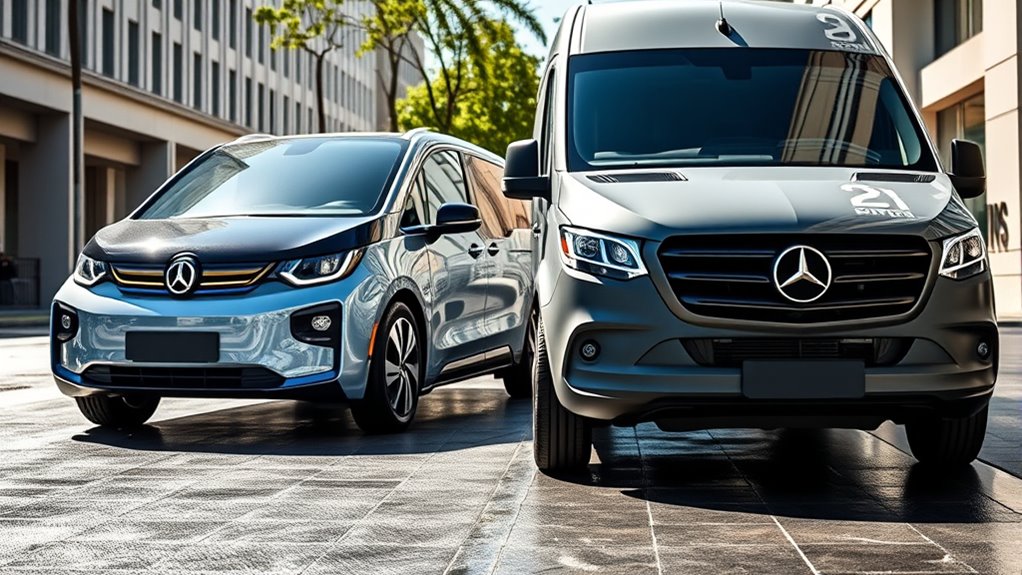
Both the Volkswagen ID.Buzz and Mercedes-Benz eSprinter offer extensive warranty and support packages, but they differ in scope and coverage.
Both the ID.Buzz and eSprinter provide comprehensive warranty packages, varying in coverage and duration.
The ID.Buzz provides an 8-year/100,000-mile high-voltage battery warranty, covering battery modules, housing, BMS, and cooling systems, with a focus on maintaining 70%+ capacity. Its new vehicle warranty lasts 4 years/50,000 miles, and roadside assistance is included for 3 years/36,000 miles, with unlimited tows for charging. The ID also offers a 5-year/100,000 km powertrain warranty and a 7-year corrosion perforation warranty. Maintenance is included for 2 years/20,000 miles, with roadside extensions through Electrify America. Access to reliable support resources can greatly enhance the ownership experience. Additionally, the availability of comprehensive merchant services can streamline maintenance scheduling and parts ordering, further improving service efficiency. Incorporating digital support platforms can also facilitate quick troubleshooting and enhance customer satisfaction. Leveraging these customer support tools can help owners resolve issues promptly and keep their vehicles operating smoothly.
In contrast, the eSprinter’s warranty details are less specific, generally offering a 3-year/unlimited-mile coverage, with support via Mercedes Pro Connect telematics, likely with a pay-per-service model.
Technology Features and Driver Assistance

Advancements in technology have made driver assistance systems standard features in the Volkswagen ID.Buzz and Mercedes-Benz eSprinter, enhancing safety and convenience. You’ll find forward-collision warning and automated emergency braking across all trims, helping prevent accidents. Lane-departure warning and lane-keeping assist keep you centered on the road. Adaptive cruise control with traffic-aware functionality maintains a safe distance without constant input.
The digital cockpit displays alerts clearly via a 10.0-inch gauge cluster. Automated parking features like self-park assist with memory, rearview cameras, and parking sensors make low-speed maneuvers easier. Optional 360-degree cameras improve spatial awareness. Connected tech, including over-the-air updates, voice controls, and app-based features, keep your driving experience current. Inspirational quotes about fatherhood highlight the importance of safety and guidance, emphasizing how integrated technology can support drivers and passengers alike.
Safety is further reinforced by high-strength frames, airbags, pre-crash protections, and emergency call systems.
Frequently Asked Questions
How Do Charging Times Compare Between ID.Buzz and Esprinter?
Charging times between the ID.Buzz and eSprinter vary based on battery size and charging method.
The ID.Buzz can reach 80% charge in about 30 minutes with DC fast charging, especially at higher wattages.
The eSprinter’s charging time depends on its battery capacity and charger compatibility, but it generally takes longer than the ID.Buzz for a full or 80% charge.
Both vehicles support fast charging, making quick top-ups possible.
What Are the Long-Term Ownership Costs for Each Vehicle?
When considering long-term ownership costs, you’ll find the ID.Buzz generally offers lower maintenance expenses, roughly $5,101 over ten years, thanks to its electric design.
Energy costs are also reduced, and warranties help manage repair costs.
The eSprinter’s maintenance might be higher due to commercial use, and insurance could be more expensive.
Are Battery Warranties Comparable for the ID.Buzz and Esprinter?
Imagine holding the keys to a future where your vehicle’s battery endures for years. Your current question teases that both the ID.Buzz and eSprinter come with substantial warranties—around 8 to 10 years—covering most concerns.
While Volkswagen guarantees at least 70% capacity retention, Mercedes’s specifics remain less clear. The real suspense lies in which warranty offers better long-term peace of mind, and you’ll need to check local terms for certainty.
How Do the Vehicles’ Payload Capacities Differ in Real-World Use?
Your payload capacity determines how much weight you can carry comfortably. The ID.Buzz offers a payload of around 948 pounds in its 1st Edition and 774 kg in the Cargo variant, which is suitable for most commercial needs.
While we don’t have specific figures for the eSprinter, industry standards suggest it can handle similar or slightly higher loads, making it a versatile choice for real-world hauling.
Which Vehicle Offers Better Resale Value Over Time?
You’re curious about which vehicle holds its value better over time. The eSprinter, with a starting price around $63,475, typically loses about 50% of its value after five years.
Meanwhile, VW models like the ID.Buzz generally retain value well, though specific data is limited.
If you prioritize commercial durability, the eSprinter might be a smarter investment. But if versatility matters, the ID.Buzz’s modern appeal could pay off.
Conclusion
Choosing between the ID.buzz and the Mercedes-Benz eSprinter is like picking between a trusty companion and a sleek ship. The ID.buzz offers a playful, versatile option perfect for city adventures, while the eSprinter’s robust performance suits long hauls. Think of it as steering your daily journey—sometimes, you need the agility of a bicycle; other times, the strength of a freightliner. Whichever you choose, your ride should match your story’s destination.
